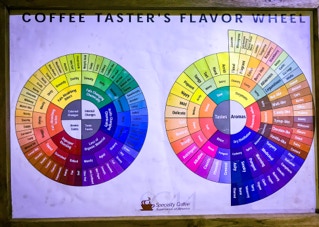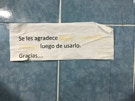Shirley was sick this morning, ostensibly from the large glass of papaya juice she had with her supper. Therefore, she and Balu did not join us for the coffee plantation tour. Roberto had the “truck” pick us up early for the tour. It seemed odd that we would be in a truck to go to a plantation, but I had no idea it would be an old one-ton army 4-wheeler with a steel cage for tourists welded on its bed!
Soon we began the climb, and I realized why we needed a truck with 4-wheel drive. The incline was VERY steep with pot holes the size of Volkswagens! We were the only Americans, with the majority of our “cage mates” originating from Germany. They had come to do the zipline from above the coffee plantation. We came for coffee.
Upon arriving, the first thing we were instructed to do, besides paying the extra fee, was to sign in triplicate waivers that basically said any accidents were strictly our fault and the corporation which owned the coffee had no responsibility for us. We signed. We hiked.
Our guide was Octavio, and he was EXCELLENT, enthusiastic, knowledgeable and thorough. We learned a boatload of information about growing coffee, harvesting coffee, drying coffee, brewing coffee, tasting coffee. I wish I’d had a recorder. The photos and captions will have to do.
Returning to the hotel for breakfast, Roberto reintroduced us to the young woman who had been serving us. She was one of 600,000 Venezuelan refugees now living in Panama - a stark reminder of the torment going on in other parts of the world. How gracious of Panama to absorb these victims.
Shirley was feeling better, so we packed up and headed back to the David airport. On the way there I was reminded that stop signs are merely a suggestion and that aggressively calculated driving is the norm. Yikes!
At the airport we had jamon & queso (ham & cheese) on hot croissants while Roberto and Balu climbed a mango tree outside to provide dessert. The only other observations about the trip back to Panama City was that the plane made two U-turns on main runways and that the arm rests all had ashtrays - reminders of a different place and a different time.


Follow the contour of the mountain or the tops of the fence posts. That’s how steep the climb was.

Once at the top, we were greeted by this lush, high altitude (6000 ft.) ecosystem.

Top is a shot from Wikimedia Commons before the suspension bridge was updated. My photo to the right shows the improved version…better, but you had to be there to appreciate the bounce and sway.

The only larger trees I’ve seen are the Redwoods in California. These are HUGE.

Geisha Coffee
Gesha, sometimes referred to as Geisha, is a variety of coffee which was originally found near the Gesha village in Ethiopia in the 1930s.
It was imported into Costa Rica and from there to the Boquete region of Panama in 2004 high up on the slopes of Volcan Baru. It has gained prominence and popularity winning competitions since then due to its unusual and distinct flavors.
What follows is more than you ever wanted to know about Geisha coffee:

After an over-land, over-bridge, under-jungle walking excursion, Octavio called our attention to a coffee plant and more specifically the flower.

An open flower indicates that a baby coffee cherry is on the way. The coffee plant reproduces by hermaphroditism. Each flower contains 5 male pollinators and 1 female receptor. Self-pollination is very efficient because it takes place in a closed flower with the 5 surrounding males dropping pollen constantly on the trapped female in the middle.

The male petals eventually fall away revealing a small green fruit which matures into a coffee cheery in about two months. The cherries are hand twisted off of the branch which stimulates the plant to produce another flower.

Octavio urged us to twist off a cherry, squish it and describe what we found - two slimy white beans. Now taste one - sweet. He explained that this is what the early Ethiopians did for a hundred or more years - suck the sweetness off of the bean and then discard it.

He then picked examples which graphically show the life cycle of a coffee bean. It takes two months for a bean to take root and two years for the plant to bloom and bear fruit.

The plant naturally drops hundreds of beans, most of which germinate right under the mother plant. However, with so much rain and shade from mother, only a few grow into robust coffee producers - most are sickly and moldy. Modern coffee producers germinate the beans in scientifically perfect conditions and plant the new trees in spacious plats open to lots of sunshine.


Right in the middle of this mighty fine lecture, Roberto started jumping up and down and screaming “Quetzal” “Quetzal” Sure enough, there were a pair of Resplendent Quetzals flying off into the distance. Wishing for a longer lens, these are the only shots I got of this rare, endangered, Guatemalan beauty.


Meanwhile, back in coffee class, Octavio was quizzing us about the various identifying characteristics of the four kinds of Geisha coffee plants. Which is the tallest? Which is the most common? Which produces the most expensive coffee? How can you tell Geisha Bronceado from Geisha Caturra? What is the best height for a coffee tree? Which beans should be taken for germinating new plants and which should be dried for shipment?
Sorry…if you want the answers, you’ll have to get into the cage with the wild Germans, climb the volcano and talk to Octavio.



Until replaced by a better one, this machine was used to remove the last layer of thin yellow skin that forms over the bean during the drying process. Trying to remove it with your fingernails is real hard work.
Geisha - The Tasting
$803 is the highest per-pound price ever paid at the coffee auction, and the purchase continues a trend in the high-end specialty coffee market in which buyers hailing from Asia, Australia, Europe and the U.S. are spending unprecedented amounts of money to secure what they believe is the best of the best. —from Daily Coffee News

